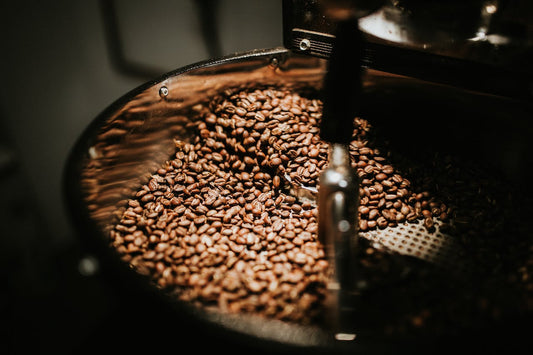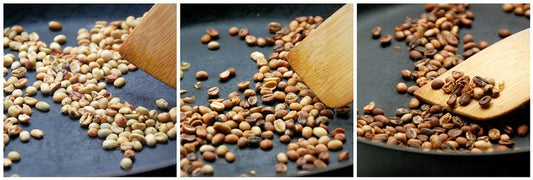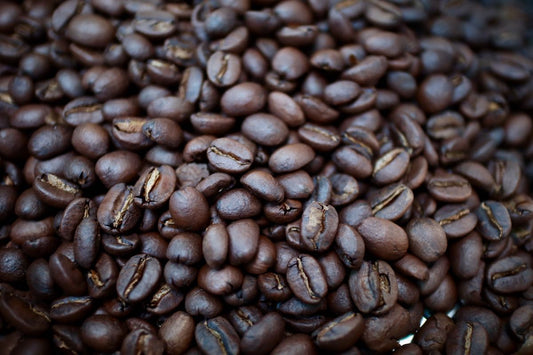
Coffee Roast Stages
Coffee roast stages are just one of the many thins you've likely come across as you learn about home roasting your coffee.
Today, We're going to look into these stages with the goal of familiarizing ourselves with what they are, some of the key aspects of them, and what they mean to your roast.
Let's start at the beginning though, with the charging of the roast
The Charge (196°C - 205°C)
When you add or drop your beans to the pre-heated roaster, this is called the "charge." While this is the official start of the roast, before you get to this point, you'll want to record 2 things.
- Bean temperature
- Air temperature
If you're fancy, you might even want to record humidity. But for must of us home roasters, this isn't a must do.
The other two characteristics can impact the roast.
Depending on the temperature of your beans and the air, the time it takes to go through the other stages will change - making it harder to plan your ideal roast profile.
When you're just starting out though, don't stress this too much. Start with just recording it and noting any observations you have about the roast relative to your starting bean and air temperatures.
Now that you've "charged" your roaster, you'll notice the temperature in your roaster (your bean temperature) will drop quickly.
It's going to drop until the beans have absorbed enough heat to match the stop reducing in temperature and begin increasing again.
This is commonly referred to as the "turning point" or the "turn around point."
While the moment the beans start absorbing heat is technically the beginning, this turning point marks the beginning of the first stage.
Let's take a look at that next.
Stage 1: Drying Phase (Temperature: 160°C - 175°C)
As you think of the drying phase, think of the green bean as a sponge that needs to dry out a bit. It does that with the application of heat within the roaster.
You'll notice you're in the drying stage becuase of two main characteristics.
- The first is smell. As moisture leaves the bean, it'll do so in the form of steam. And the aroma will be that of wet hay.
- The second is color. The bean will begin to lighten in color first to a pale green and then slowly to yellow.
When the bean moves beyond a yellow color and starts to tan, you'll know you've finished the drying stage and moved into the browning stage.
Now we're in the second stage.
Stage 2: Browning Phase (Temperature: 170°C - 205°C)
Now, the beans are free of moisture, and the beans themselves begin to chemically change.
Technically, the changes are part of what's known as the Maillard Reaction.
When thinking about the maillard reaction, I like to think of carmelizing onions. They start off crisp, white and with a sharp flavor. After a while though, the begin to brown, soften, and develop a sweet taste.
This is pretty much what happens to the beans too.
With coffee though, you'll notice the bean will become brown, and you'll begin to smell the rich tones of caramel as you move toward first crack.
First crack is a point in the roast where you can actually hear the roasting process take place.
It's also, the begining of what's called the development phase.
Stage 3: Development (Temperature: 205°C - 240°C)
While I'll save you my rant about the development of flavor starting the moment you charge the beans and introduce them to heat, let's talk about the development in terms of flavor development as it relates to roast level.
First Crack
Coffee is "drinkable" from the moment first crack starts to the point it catches on fire.
Depending on your preference, you'll roast it to a certain level within in that range. We call these levels light, medium, dark, and so on.
You can read more about coffee roast levels here.
The development phase is a narrow window of time that coffee beans move through those levels during the roasting process.
This is why it's called the development phase, it's the time within the roast that is most easily related to flavor.
Second Crack
Within the development stage, if you stay there long enough, you'll also hear what's known as second crack.
This marks both the start of the "dark" roasts, and also the point at which the beans themselves structurally change as a result of exposure to heat.
Most of us in the home roasting world won't take beans this deep into the roast, but it's good to know a bit about it.
Regardless of how deep you go in the roast though, after you drop the beans, the next phase is the cooling phase.
Stage 4: Cooling Phase (Temperature: Drop to Room Temp)
Have you ever noticed when you cook eggs that the keep cooking for a bit even when you take them out of the pan?
The same thing happens with coffee.
If you want a light roast and drop them accordingly, if you don't cool them quickly enough (within 1-2 minutes)you can end up with a more developed roast and a different end result in your cup.
Obviously, this isn't ideal.
So no matter how you roast your beans, having a way to cool them quickly is super important.
The cooling tray I've had pretty great success with is this one on amazon.
Once you've cooled the beans though, it's time to store them and let them rest before brewing and sharing.
Storing Your Roasted Beans
Okay, so this isn't really a "stage" in the roasting process persay, but it is key.
After you've cooled the beans, the coffee will continue to off-gas CO2 until it's consumed. This is perfectly normal and why coffee needs to "rest" for a few days. Typically 24-72 hrs (1-3 days)
The best way to rest the beans is to store them in a cool dark place with a container that has a de-gassing valve.
I like to use these tin cans from Sweet Marias
Wrapping it all up
From bean to ready to drink, every cup of coffee you drink goes through these stages.
And the best part about home roasting, is that you can influence them to your own tastes and preferences. Which is super fun!
You can probably guess too, that there's a lot more about each one of these stages, roasting temperatures, roast levels, and how to create winning roast profiles.
If you want to learn more, dig in and continue to expand your knowledge about home roasting. But don't forget to put what you learn in practice, experience will teach you far more than any blog ever can!
Happy roasting!



